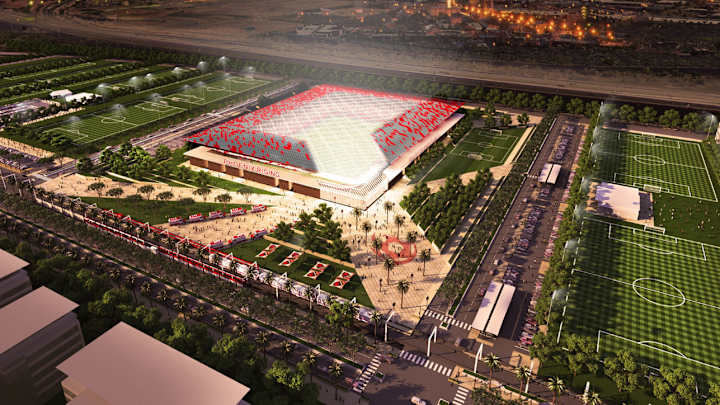MLS expansion city profile: Phoenix

Market Analysis
After spending his childhood watching soccer in Hell, Berke Bakay isn’t cowed by the prospect of making it work in the desert. In fact, he’s certain that he’s found the formula and that the Valley of the Sun, home to the country’s hottest major city, is the ideal spot for an MLS team.
“Phoenix has shown all the right attributes. If you put a good product out there, the fan base is there,” Bakay said. “I don’t know how you can objectively look at what MLS is trying to accomplish—local and passionate ownership, our stadium solution and the right market—and not put us on the top of the list.”
Bakay, 38, is a native of Istanbul and a born-and-bred supporter of Turkish powerhouse Galatasaray. He has an uncle who sat on the club board and said, “You can count on my fingers the number of games I have missed in my life.”
Until 2011, seeing Galatasaray in person meant going to the Ali Sami Yen, which its denizens called “Hell” thanks to the red and yellow colors, frequent flares and smoke, and ear-splitting noise. There wasn’t a more intimidating setting in Europe, and Bakay said he missed it as soon he left Turkey to attend Boston College. He moved to Dallas after school and then on to Phoenix, where he parlayed his work in investing and private equity into control of a restaurant chain called Kona Grill. But even as his career progressed, he always kept one eye on the ball.
“It always kind of stretched my head about why [soccer] wasn’t taken even more seriously in the realm of all these sports in the United States,” he said. “But like any investment I make, I believe in the fundamentals of the sport and its growth in the coming years.”
Mailbag: Premier League predictions, LAFC's ideal DPs and more of your questions
Bakay is the lead owner of Phoenix Rising, a relatively new but ambitious USL club that intends to make the move to MLS. Bakay said his big-league pitch is anchored by an understanding of the Valley’s demographics, its unique assets and challenges and a stadium site that makes the most of the former.
Phoenix anchors the country’s 12th-most populous metro area, which makes it the largest of the 12 cities seeking MLS entry. It’s home to four Fortune 500 companies. As a media market, Phoenix ranks 12th again, just behind Tampa/St. Petersburg. Measured by only Hispanic households, however, Phoenix shoots to ninth overall. Reaching those fans is one of Bakay’s primary missions.
“My wife is Mexican. My kids are bilingual. I consider myself lucky, because I live in that culture,” Bakay said. “A lot of my friends are Mexican and I listen to them and what they’re looking for. I think there’s a very positive opportunity to connect the dots in ways other teams weren't able to before.”
Those dots, Bakay said, are key to understanding Phoenix. There are Hispanics, who comprise nearly 30% of a metro area population that exceeds 4.5 million. Phoenix Rising will broadcast each of its games in Spanish this season, Bakay said. Last week, the club signed El Tri legend Omar Bravo. There are millennials and students, many of whom attend Arizona State in Tempe. The club estimates that there are 2.7 million people under 45 in the area. ASU is one of the country’s largest universities, and Forbes placed Phoenix/Tempe in 16th on its list of “Best Cities and Neighborhoods for Millennials.” Last month, Forbes ranked Phoenix as the 16th fastest-growing city in the country.
Finally, there’s the youth soccer community, with which Rising is already working, and the Valley’s business community, which is anchored by offices downtown and corporate headquarters and high-income neighborhoods to the east. The club intends to build a stadium right in between.

Ownership Group
Call it “LAFC Lite.” The Phoenix investor group doesn’t have all the star power of the 2018 MLS entrant’s, but it does feature some recognizable names from beyond the soccer world. Bakay and his partners bought the club, then called Arizona United, last August. He owns a controlling stake (MLS requires the lead owner to hold at least 35% of the club). And he’s got plenty of support. Tim Riester owns a large marketing, PR and advertising firm headquartered in Phoenix. Dave Stearns co-founded a wireless communications company and a wine business. Dr. Christopher Yeung is an orthopedic spine surgeon and works with several Major League Baseball teams.
There’s another baseball connection to Rising. Los Angeles Dodgers pitcher Brandon McCarthy is an investor. He’s a Liverpool fan. On the pop culture front, the club counts musicians Pete Wentz and Diplo among its investors. Wentz is the bassist for Fall Out Boy and grew up playing soccer outside Chicago. Diplo is a DJ, electronic musician and producer whose Mad Decent label is Rising’s uniform sponsor. He bought into Arizona United before Bakay’s group came aboard. Rising will benefit from their money, connections and seven million-plus Twitter followers.
“The last thing you want to do in partnerships is putting people together with the same skill sets,” Bakay said.
Stadium Plan
The 510-acre site lies just northwest of the intersection of Loops 101 and 202 and at the southwest corner of the Salt-River Pima Maricopa Indian Reservation.
“If you asked a random 1,000 people where would be the best place to put a stadium, and gave them a multiple choice section, I don’t see how this doesn’t dominate it. It’s not debatable,” Bakay said.
It’s about 13 miles east of downtown Phoenix and 2-3 miles from ASU. Bakay said that more than 300,000 cars whiz past it every day, and that the location between downtown and the eastern suburbs is so ideal that when MLS first looked at the Valley more than a dozen years ago, it identified the same site.
“Literally, the tribe has been holding onto this site for a group to bring an MLS team. They have refused dozens of opportunities. They’ve been holding on for a team,” Bakay said.
Phoenix Rising already has the land under control and will play its USL schedule in a temporary venue of at least 6,000 seats. But should MLS come calling, it plans to construct a climate-controlled venue anchoring a multi-field soccer and training complex and additional mixed-use development. Rising has 45 acres under lease and HOK already completed some stadium design work. It includes the possibility of photovoltaic panels that can store energy.
No public money will be required, Bakay said, although Rising will be able to avoid property taxes because construction will occur on reservation land. The stadium and complex will be funded by the investor group, the Native American community and some third-party financing. Bakay would not reveal the breakdown or cost.
U.S. Soccer hires EPL's sports science guru to accelerate, improve youth development
Soccer and Sports Scene
The influx of pro sports teams is an easy way to measure the Valley’s growth. In the mid 1960s, Phoenix had no major league franchises, and in the mid 1980s it had one. Now there’s MLB, NBA, NFL, NHL and WNBA all competing for attention, as well as football and basketball at ASU. Annual events include car races, golf tournaments, baseball spring training and college football bowl games. The Phoenix area has hosted three Super Bowls, most recently XLIX in January 2015.
The city’s MLB, NBA, NFL and NHL teams have combined to win only one championship and the hockey team, the Coyotes, struggles to draw fans out in the western suburb of Glendale. Their future is a constant subject of scrutiny. The Cardinals, Suns and Diamondbacks all do relatively well, even if they struggle for relevance nationally.
Instead, the area hits the headlines when it hosts a big event like the Super Bowl or a College Football Playoff-relevant Fiesta Bowl. The same has been true for soccer. The Cardinals’ University of Phoenix Stadium hosted three matches at last year’s Copa América Centenario and group-stage games at the 2015 CONCACAF Gold Cup. This summer, it will be the site of a quarterfinal doubleheader. As Bakay suggested, Mexico draws well. More than 43,000 witnessed a friendly between El Tri and Denmark in 2013 and the following year, Mexico and the USA prepared for the World Cup with a 2-2 draw that attracted 59,000. That was the fifth of six appearances by the American men in the Valley of the Sun. The U.S. women haven also played there six times.
Soccer has made much less of an impact at the club level. Rising is the third iteration of a USL team that launched in 2013. Phoenix FC lasted one season, finished second-to-last and subsequently had its franchise revoked by the league, which passed those rights on to advertising executive Kyle Eng and Arizona United. But that club never found a foothold playing at a baseball stadium in far-flung Peoria in 2014 and ’16 or a baseball stadium in Scottsdale in ’15. It drew an average home crowd of just 1,470 last year, third-worst among the USL’s independent clubs. A new NPSL team called FC Arizona will play its inaugural season at Mesa Community College, which is about five miles south of Rising’s stadium site.
Bakay said the region’s soccer interest can’t be judged by the aforementioned attendance figures because of the type and location of previous stadiums. He’s betting on bigger numbers this year. Part of that increase will come from tapping into a more robust youth soccer market. The club will start by partnering with Arizona’s state association to lend the Rising name to its two chief state-wide leagues.
Clint Dempsey says he's 'feeling good,' is cleared to play in games
MLS Pros
Phoenix offers the raw population numbers and TV households that would appeal to any major sports league, and those numbers are only going to grow. And the demographics might appeal specifically to MLS.
“MLS certainly is extremely interested in connecting Mexico to this whole thing from a fan base perspective,” Bakay said. “How are we going to penetrate the Mexican audience? I feel like we have a competitive advantage related to other ownership groups.”
Phoenix certainly represents a wide-open space in the league map. It’s a long way from Los Angeles to Colorado or Texas. And if the stadium and field-complex Rising are proposing gets built, it would be one of the finest in the country.
MLS Cons
There may be good reasons for it, but it remains a fact that there’s no history of proven support for pro soccer in the area. MLS has more reliable options elsewhere. The league also may decide that it’s a saturated sports market. In the expansion race, Phoenix has heavy competition out west in the form of Sacramento and San Diego.
